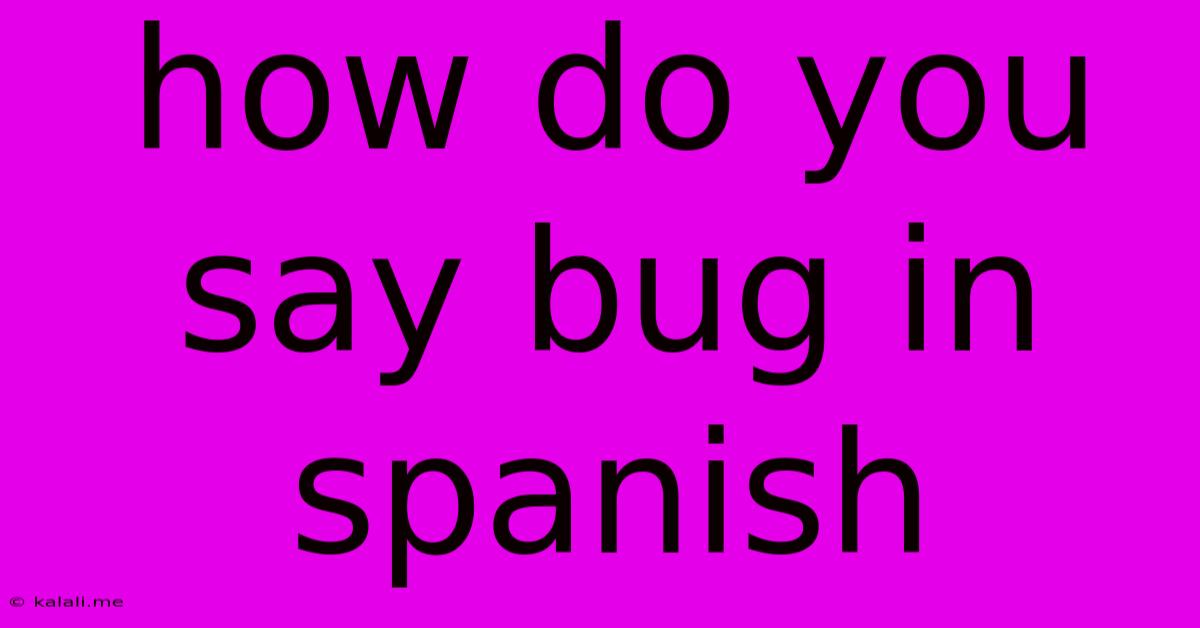How Do You Say Bug In Spanish
Kalali
Jun 01, 2025 · 2 min read

Table of Contents
How Do You Say "Bug" in Spanish? It's More Than Just One Word!
Finding the right Spanish translation for the English word "bug" depends heavily on the context. Are you talking about an insect? A software glitch? A hidden listening device? This article explores the various Spanish words used and helps you choose the perfect translation. Understanding the nuances will significantly improve your Spanish communication skills and avoid any misunderstandings.
There isn't one single perfect translation for "bug," as the word's meaning is quite broad in English. Let's break down the different scenarios and the appropriate Spanish equivalents:
"Bug" as an Insect
When referring to an insect, the most common and straightforward translation is "insecto." This is a general term and works in most situations. However, you might also use more specific words depending on the type of insect:
- Mosquito: Mosquito
- Araña: Spider
- Hormiga: Ant
- Cucaracha: Cockroach
- Abeja: Bee
- Mariposa: Butterfly
If you're talking about a bug as a general nuisance, you could also use "bicho." While technically meaning "creature," "bicho" is often used colloquially to refer to insects, especially small ones that are annoying. For example, you might say, "¡Qué bicho molesto!" ("What an annoying bug!")
"Bug" as a Software Glitch or Error
In the context of programming or technology, the word "bug" referring to a software error is typically translated as "fallo," "error," "glitch," or "bug" (yes, sometimes it's borrowed directly!). The choice often depends on the level of formality and the specific nuance you want to convey.
- Fallo: This is a more general term for a failure or malfunction.
- Error: A direct and widely understood term for a mistake in a program.
- Glitch: This word is frequently used in its English form, especially in informal settings, and is widely understood.
For example, you could say, "Hay un fallo en el sistema" ("There's a system failure"), or "El programa tiene un bug" ("The program has a bug").
"Bug" as a Hidden Listening Device
In this case, the most appropriate translation would be "micrófono oculto" (hidden microphone) or "escucha" (a listening device). The word "chinche," while sometimes used to refer to a bug, is rarely used in this context and can be confusing.
Choosing the Right Word: Context is Key
Remember, the key to correctly translating "bug" in Spanish lies in understanding the context. Consider what type of "bug" you're referring to before choosing a translation. Pay attention to the situation and use the most appropriate and precise word to ensure clear communication. Using the wrong word might lead to humorous, or even problematic, misunderstandings.
Latest Posts
Latest Posts
-
Validate Crud Permission Before Soql Dml Operation
Jun 03, 2025
-
How To Get Hair Dye Out Of Wood Floor
Jun 03, 2025
-
Garage Door Not Opening All The Way
Jun 03, 2025
-
How To Clean Hot Water Tank
Jun 03, 2025
-
How Spicy Is A Ghost Pepper
Jun 03, 2025
Related Post
Thank you for visiting our website which covers about How Do You Say Bug In Spanish . We hope the information provided has been useful to you. Feel free to contact us if you have any questions or need further assistance. See you next time and don't miss to bookmark.